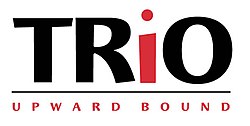Upward Bound

TRIO Upward Bound logo.
|
|
| Formation | August 26, 1965 |
|---|---|
| Location | |
| Website | www2 |
Upward Bound is a federally funded educational program within the United States. The program is one of a cluster of programs now referred to as TRIO, all of which owe their existence to the federal Economic Opportunity Act of 1964 (the War on Poverty Program) and the Higher Education Act of 1965. Upward Bound programs are implemented and monitored by the United States Department of Education. The goal of Upward Bound is to provide certain categories of high school students better opportunities for attending college. The categories of greatest concern are those with low income, those with parents who did not attend college, and those living in rural areas. The program works through individual grants, each of which covers a restricted geographic area and provides services to approximately 50 to 100 students annually.
The program was launched in the summer of 1965 after the passage of the Economic Opportunity Act of 1964 (The Federal War on Poverty) during President Lyndon B. Johnson's administration, and was transferred to the Department of Education after the enactment of the Higher Education Act of 1965. The idea of Upward Bound came from Stan Salett, a civil rights organizer, national education policy advisor and one of the creators of the Head Start Program. Upward Bound has an annual budget around $250,000,000. Grants are usually made to institutes of lower education (universities), but some awards have been made to other non-profit organizations such as tribal organizations. Each award made averages $4,691 per participant, with the most common award providing $220,000 per grantee in 2004 and $250,000 in 2007. Awards are for four or five years and are competitive. The law providing for Upward Bound is 34 CFR Ch. VI Pt. 645. As federal education grants, Upward Bound awards fall under EDGAR and OMB Circular A-21 financial guidelines.
Upward Bound grants are results-based, with the level of success determined largely from highly structured annual reports compared to grant objectives. The program is available to students after their eighth grade of school. Two-thirds of selected applicants must be low-income and "potential first-generation college students," with the remaining third of students meeting one of the requirements.
...
Wikipedia
